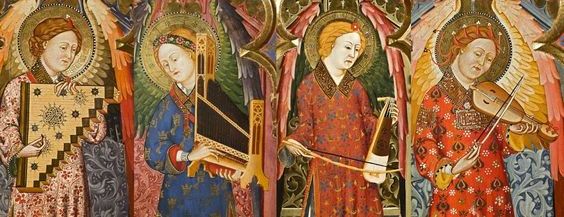 The gittern was one of the most important plucked fingerboard instruments of the late medieval period. Loved by all levels of society, it was played by royal appointment, in religious service, in taverns, for singing, for dancing, and in duets with the lute. Yet we know of no specific pieces played on this instrument. What we do have are many representations of it being played in a wide variety of contexts and one surviving instrument of the 15th century, and from this we can reconstruct something of the history and repertoire of this widely-loved instrument. This article begins with a video of an estampie from c. 1300 played on gittern.
The gittern was one of the most important plucked fingerboard instruments of the late medieval period. Loved by all levels of society, it was played by royal appointment, in religious service, in taverns, for singing, for dancing, and in duets with the lute. Yet we know of no specific pieces played on this instrument. What we do have are many representations of it being played in a wide variety of contexts and one surviving instrument of the 15th century, and from this we can reconstruct something of the history and repertoire of this widely-loved instrument. This article begins with a video of an estampie from c. 1300 played on gittern.
gittern
The lute: a brief history from the 13th to the 18th century

The lute’s musical versatility, giving one musician the ability to play several polyphonic parts over a wide and increasing pitch range, made it once the most popular instrument in Europe, the ‘prince’ of all instruments. From the Arabian oud to the medieval, renaissance and baroque lutes, this article briefly charts the development of this versatile, beautiful and enduring instrument, featuring 8 videos illustrating the changes and developments of the lute and its music.
Medieval music: a quick guide to the middle ages
 This article is a complete beginner’s guide to secular medieval music. When were the middle ages? What musical information is available in medieval manuscripts? What were the earliest surviving secular songs in English? What was medieval dance like? What forms of music did musicians play? Why does medieval music sound so different to today’s? How did medieval musicians harmonise?
This article is a complete beginner’s guide to secular medieval music. When were the middle ages? What musical information is available in medieval manuscripts? What were the earliest surviving secular songs in English? What was medieval dance like? What forms of music did musicians play? Why does medieval music sound so different to today’s? How did medieval musicians harmonise?
This article features 5 illustrative videos of medieval music and several links to further articles.
The beautiful Boissart mandore, part 2 of 3: Observations on the Boissart mandore
The history of a stunning 16th century instrument, observations on its lutherie, and questions over its dating.
In part 1 we looked at the history of the renaissance and baroque mandore. Now we examine one exquisite instrument, the Boissart mandore in the Victoria and Albert Museum, London, decoding its remarkable carvings and reconstructing its biography from the visible evidence of the changes it has been through. As far as I know, this is the first critical examination of the life of the Boissart mandore.

(As with all pictures, click to see larger in a new window, click in new window to further enlarge.)
The beautiful Boissart mandore, part 1 of 3: The pre-history of the mandore
The history of a stunning 16th century instrument, observations on its lutherie, and questions over its dating.

of the Victoria and Albert Museum, London. (As with all pictures, click for a larger view.)
In the family of renaissance plucked instruments, the mandore is the result of a union between two mediaeval string families: the oud and the lute on one side, and the gittern on the other. The resulting offspring is a small instrument with a musically significant (but alas now largely unplayed) surviving repertoire. Some actual instruments survive, and there is no doubt that the most exquisite of these is the beautiful Boissart mandore in the Victoria and Albert Museum. This article and two to follow will: (1) trace the pre-history of the mandore; (2) examine the V&A’s beautiful Boissart mandore and attempt to reconstruct its personal history for, as far as I know, the first time; (3) describe the making of a new mandore based on the Boissart model.
